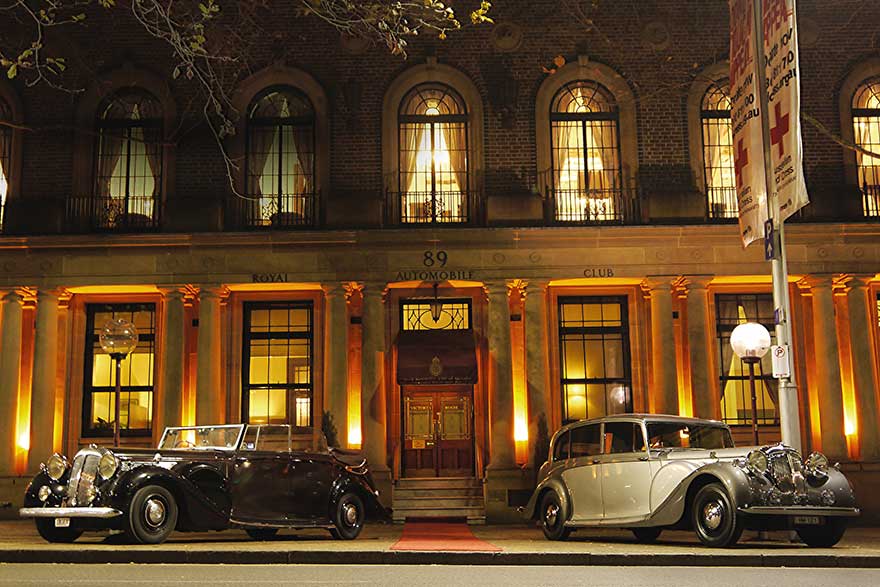Originally set up over one hundred years ago to “foster motoring and assist motorists”, THE ROYAL AUTOMOBILE CLUB OF AUSTRALIA is now a club for the local professional and business community in Sydney.
It’s difficult to imagine the world without motorised vehicles to get you from A to B in a reasonably short period of time. So ubiquitous are cars now, with our cities and infrastructure designed around their needs, that it is astonishing that there was once a time when a “horseless carriage” would have had people running to marvel at it. The first serially produced vehicles with combustion engines became available 130 years ago, and largescale manufacturing commenced only at the beginning of the 20th century. But such was the appeal of these machines, that the early adopters – usually wealthy individuals or those with an appetite for novelties – were prepared to invest significant amounts of money and time to pursue their hobby. And as with most hobbies, there comes a time when one wishes to engage with other like-minded individuals and perhaps spread the word. What better place to do exactly this, thought Henry Skinner, than a club dedicated to the pleasures of motoring? Skinner, who had come to Australia with his parents in 1870, was the consummate showman and possessed of an irrepressibly pioneering spirit. After his arrival, he took up a secure job in a bank but didn’t stick it for long, abandoning his teller’s desk and running away to join the circus. Here, he rose through the ranks, going from running sideshows to working for one of the biggest names in Australian theatre, bringing international variety acts to the continent and managing several theatres. Skinner always had more than one string to his bow: he is credited with introducing the gramophone to Sydney, he published a popular gazetteer and laid a telegraph line. Naturally, he was an instant enthusiast for the new automobiles that were arriving in Australia. After encountering some of the challenges of very early motoring – such as running out of petrol and having to have supplies sent by train – Skinner decided to set up a club and in 1903, the Automobile Club of Australia was officially formed. In the first decade of operation, it focussed on hosting competitive events for automobile owners; it also negotiated with country hoteliers to stock fuel, making them Australia’s first petrol stations. Shortly after, the government put the club in charge of issuing competency certificates to drivers. Over the coming decades, the club worked closely with traffic authorities to define rules, such as the need for cars to have brakes and mandatory speed limits. In 1919, King George V conferred the “royal” status on the club, which was now allowed to call itself the Royal Automobile Club of Australia (RACA). With all these activities and a rising membership, it was time for a clubhouse that reflected the club’s status. A plot was acquired in Macquarie Street in Sydney and architects were brought in to design a suitably elegant domicile in the popular commercial palazzo style. The new clubhouse, which is now a listed building, opened at the beginning of the 1930s to great acclaim. It offered all the facilities RACA’s members could dream of plus a broad range of activities themed around the automobile, including motor sports and touring. RACA continued to lobby to define motoring legislation, to safeguard the rights of motorists and – until 1945 – to provide roadside assistance and insurance. From 1953, the club started welcoming members from the local business community and the city. A health club was added, and the focus gradually shifted away from motoring. In 1986, the Imperial Services Club was incorporated, opening the club for active and retired members of the armed services.
Situated in downtown Sydney, the RACA clubhouse boasts an unrivalled location: the famous Opera House and the harbour are mere minutes away and the Botanic Gardens are directly opposite. Inside, the clubhouse brims with character and old-world charm. The lobby opens up into a grand hall with marble floors and columns, from which terrazzo stairs lead up to the elegant rooms on the upper floors, offering facilities for functions, meetings and social events. Breakfast, lunch and dinner are served in the dining room overlooking Sydney Harbour. Members and their guests can enjoy informal meals and a wide choice of select wines, cocktails and other beverages in the members’ bar in the Victoria Room, a grand room with a stainedglass dome and vintage chandelier as a stunning centrepiece.
The club has 29 bedrooms for members and guests, some overlooking Sydney Harbour or the Botanical Gardens. There are function suites for corporate meetings, launches or networking events as well as a business area for working in the club.
RACA hosts a wide choice of social events and, in keeping with its historic association with cars and motoring, has just launched the Historic Motoring Awards, a set of annual accolades recognising excellence and outstanding contributions to Australia’s historic motoring and motorsport industries. Categories include Car of the Year and Restoration of the Year. The awards will be presented on 20 November 2020 at an event billed as a celebration of all that’s best in the classic car industry in Australia. It promises to showcase some stunning vintage cars – though perhaps not any harking back to the very early days of the club.
Royal Automobile Club of Australia
89 Macquarie Street, Sydney, NSW 2000
Tel: +61 (02) 8273 2300
reception@raca.com.au
www.raca.com.au
